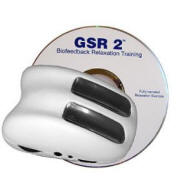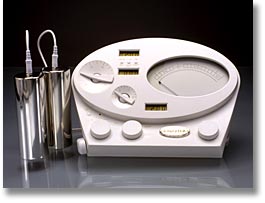U.S. DEPARTMENT OF HEALTH AND HUMAN SERVICES
Food and Drug Administration
Center for Devices and Radiological Health
Rockville, MD 20850
Neurological Devices Branch
Division of Cardiovascular, Respiratory and Neurological Devices
Office of Device Evaluation
August 1994
Skin Response Measurement Devices - Draft Guidance For 510(K) Content
INTRODUCTION
This guidance is to be used in conjunction with the Division of Cardiovascular, Respiratory and Neurological Devices "Draft Guidance for Format and Content for Premarket Notification 510(k)", which provides general guidance for preparing a "510(k)" premarket notification. Its purpose is to provide specific applicable to 510(k)s that claim equivalence to Galvanic Skin Response measurement (GSR) devices.
I. BASIC DESIGN DESCRIPTION
The file must include a complete and precise description of the device including a description of the functional characteristics, the controls, and all data provided to the user. This must include pictures or drawings of the device showing all controls, indicators, displays and connections. Copies of all programmable displays must be provided. The intended use must be clearly stated and must be consistent with the "indications" specified in the product labeling.
II. COMPARATIVE DEVICE SPECIFICATIONS
- If the device is line-powered, the file must describe the design features that assure the patient will be isolated from AC line voltage under any condition of electrical component failure. This should take into consideration the effect of any line-powered accessories that connect to the device, and the use of a line-powered battery charger if the device is powered by a low voltage battery. All testing performed to assure patient safety should be described and explained.
- The electrical connection between the device and the patient leads must be described in detail. If connectors are used, there must be an explanation of the method used to preclude accidental connection to a dangerous power source, e.g. an AC power outlet. (See Ref. 3.)
The manufacturer (or importer) is to provide a discussion indicating the similarity and/or difference of the device to legally marketed comparable products which are used for GSR device, accompanied by data to support the statement. This should include an identification of similar products, design considerations, energy delivered by the device, and a description of the operation principles of the device. The firm that intends to market the device must be specific as to the similarities and differences in regard to the device to which it is being compared. The comparison must include the physiological parameters being monitored, the data provided to the user, the intended use and any other feature which could impact on safety or effectiveness. Pictures, drawings, and labeling, sufficient to describe the similarities and differences between the devices are to be included. If the predicate device was the subject of any prior premarket notifications, file numbers for those documents should be specified to facilitate the review.
A. Measurements
The file must describe in detail the electrical circuitry by which measurements are performed and the means by which they are assured to be accurate and repeatable. Performance specifications must be provide and compared with those of the predicate device.
B. Data and Displays
All displays and other output data provided by the device must be completely described. This should include a discussion that explains the relevancy of any data provided by GSR device to its intended use. Copies of all displays produced by the device must be included in the file, along with the numeric range, units of measurement and increments of the displays.
C. Electrical Safety
D. Electrodes
The electrodes to be used with the device must be completely and accurately described. This description should include drawings with dimensions and specification of the composition of all materials employed.
E. Intentional Electrical Current
An accurate specification of the electrical signal employed by the device to measure skin resistance must be provided. The waveshape and the maximum amplitude of the signal must be clearly specified. There must be an explanation of the basis on which the manufacturer has determined that this intentional current is safe.
F. Risk of Thermal Injury
An explanation must be provided, accompanied with data, that assures that the heat produced by the electrical energy will not injury to the subject's skin. Calculations showing that the average current density does not exceed 0.25 watts per square centimeter will suffice.
III. INDUSTRY STANDARDS
The manufacturer must indicate the extent to which the device conforms to any industry standard (i.e., UL544, or any other electrical safety standard).
IV. TEST DATA
The manufacturer must provide performance data demonstrating that the device performs as safely and as effectively as a legally marketed predicate device, and that it meets the design requirements. This data can be obtained from bench testing or "in vitro" testing performed on the device. Data should include the protocol for the testing, the pass-fail criteria, and the test results. A summary explanation of how the testing demonstrates that the design requirements are satisfied and how the design requirements are related to device performance should also be included.
A. Environmental Testing
A discussion should be included explaining the assurances the manufacturer has that the device will perform reliably in the environment in which it is intended to be used. The discussion should include any data from environmental testing that has been performed, and an analysis of that data. Identification of testing equipment and procedures should be included in the discussion.
B. Software
For devices that employ microprocessors or other software-controlled components, the type of information needed in the file is specified in the Reviewer Guidance Document for Computer Controlled Medical Devices. (See Ref. 6.) The file must include a hazard analysis and must specify the level of concern as described in Chapter 2 of Reference 6. As discussed in the reference, the software information is to be provided with a level of detail consistent with the level of concern.
V. LABELING
The file must include copies of all proposed label, labeling, and advertisements. If this material has not been developed, drafts of the text must be provided which are sufficient to describe the intended use for which the device will be promoted and to provide adequate directions for use.
GSR devices which have labeling that implies that GSR can be useful in the diagnosis of any physiological condition or disease require prescription legend pursuant to Title 21, Code of Federal Regulations, Section 801.109 (21 CFR 801.109) (enclosed). Lack of a prescription legend can affect classification.
A. Intended Uses
Preamendment GSR device devices were intended only for the measurement of skin resistance (i.e., conductance). Any other intended use diagnostic capability must be supported by valid scientific data. Documentation must describe clinical studies that utilized the subject device, the results of the study, and analysis that supports the claim of effectiveness. If a new use raises new scientific issues, then the device is a new device, i.e., it is not equivalent to preamendment GSR devices.
We are not aware of any predicate GSR device that has any specific diagnostic capability, nor is there any scientific evidence that GSR devices can be used to diagnose any particular disease.
B. Instructions for Use
The instructions for use must explain how the device is to be used to accomplish its intended use and must explain the purpose and function of all accessories, displays, data, and connectors and how they are to be used. These instructions must identify all electrodes to which the device is to be connected and explain their use.
C. Indicators and Displays
-
The meter scales, digital values and other data that are
presented to user must be related to real physical
measurements (i.e., ohms or mhos) and this relationship must
be explained in the instructions for use. The labeling must
specify the accuracy with which the device indicators can be
translated into physical measurements.
___________________
This guidance was written prior to the February 27, 1997 implementation of FDA's Good Guidance Practices, GGP's. It does not create or confer rights for or on any person and does not operate to bind FDA or the public. An alternative approach may be used if such approach satisfies the requirements of the applicable statute, regulations, or both. This guidance will be updated in the next revision to include the standard elements of GGP's.
This guidance document may contain references to addresses and telephone numbers that are now obsolete. The following contact information is to be used instead:
- While this guidance document represents a final document, comments and suggestions may be submitted at any time for Agency consideration to the General Surgical Devices Branch, 9200 Corporate Blvd., HFZ-410, Rockville, MD 20850.
- For questions regarding the use or interpretation of this guidance, contact the General Surgical Devices Branch at 301- 594-1307.
- To contact the Division of Small Manufacturers Assistance (DSMA), call 800-638-2041 or 301-443-6597; fax 301-443-8818; email dsmo@cdrh.fda.gov; or write to DSMA (HFZ-200), Food and Drug Administration, 1350 Piccard Drive, Rockville, Maryland 20850-4307. FACTS-ON-DEMAND (800-899-0381 or 301-827-0111) and the CDRH home page also provide easy access to the latest information and operating policies and procedures.
REFERENCES
- "Connection of Electrode Lead Wires to Line Power,"Health Devices, Emergency Care Research Institute, pp.44-46, Feb. 1987.
- "Risk of Electric Shock from Patient Monitoring Cables and Electrode Lead Wires,"Health Devices, Emergency Care Research Institute, pp.301-303.
- "FDA Public Health Advisory: Unsafe Electrode Lead Wires and Patient Cables Used With Medical Devices," December 28, 1993.
- American National Standard, Safe Current Limits for Electromedical Apparatus ANSI/AAMI ES1 1985. Association for the Advancement of Medical Instrumentation, 1901 North Fort Meyer Drive, Suite 602, Arlington, Virginia 22209.
- Standard for Medical and Dental Equipment—UL 544, Second Edition 1976, (Reprinted May 21, 1992), Underwriters Laboratories, Inc., 333 Pfingsten Road, Northbrook, Illinois 60062.
- "Reviewer Guidance for Computer Controlled Medical Devices," Center for Devices and Radiological Health, August 29, 1991.













